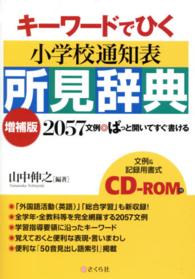Full Description
One of the most popular literary genres, memoir can provide literary and literacy access to reluctant adolescent readers and writers, and help bridge the achievement gap by motivating students to read more critically and write more meaningfully about what matters most to them. The introspective nature of memoir helps students learn about themselves and connect with their environment or community, while also meeting a variety of Common Core standards.
In this way, memoirs and creative nonfiction can provide a bridge between
fiction and nonfiction reading, narrative and informative writing, reading and writing, and can afford a "way in" to literacy for all adolescents.
Special features of the book:
examples of multiple mentor texts in each chapterteacher examples with think-aloud exercisesa variety of student samples from diverse learnersactivities to engage all learnersan appendix of teacher resources a reference list of over 150 full-length memoirs for grades 5-12 for whole-class, book club, or independent readinga list of writing resources for students and teachers12 full-size reproducible materials for teacher and student usea variety of reading, writing, speaking, and listening strategies and activitiesacross-disciplines applications and adaptations for diverse learnersdaily writing focus lessons in gradual-release-responsibility formatCommon Core State Standard connections at the end of each chapter
Contents
Introduction: The Why, How, and When of Writing Memoirs
Chapter 1 Defining and Gathering Memories
Chapter 2 From Memories to Memoir
Chapter 3 Reading Memoirs: Reading Like a Writer
Chapter 4 Memoirs about Time and Age
Chapter 5 Memoirs about Objects and Mementos
Chapter 6 Memoirs about Places
Chapter 7 Memoirs about People and Relationships
Chapter 8 Memoirs about Crises and Defining Moments or Events
Chapter 9 Memoirs about Where We Are From and Who We Have Become
Chapter 10 Analyzing Memoir Writing: Learning from Mentor Texts
Chapter 11 Genre Choice: Making the Form Fit the Function
Chapter 12 Memoir Writing Lessons: Taking Rough Drafts to Publication
Conclusion: Memoir and Creative Nonfiction Writing Across Disciplines
Appendix A: Resources for Teachers
Appendix B: Resources for Readers
Appendix C: Resources for Writers
Appendix D: Full Page Reproducible Forms for Memoir Readers and Writers
Sensory Memory Triggers
Memories Chart—page 1
Memories Chart—page 2
Heart Map
Memory Time Graph
Age Pros and Cons Chart
Small Moment Memories Chart—page 1
Small Moment Memories Chart—page 2
Memoir Double-Entry Response Journal—page 1
Memoir Double-Entry Response Journal—page 2
Memoir Triple-Column Response Journal
Crisis Response Journal








